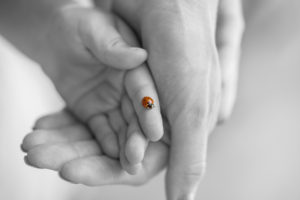 Since lady is defined as “a woman of good family, social position, breeding, etc.,” this may refer to the fact that most species of this beetle family are highly beneficial insects; only 3 of 475 United States species are not beneficial. Some species have a habit of overwintering in structures and are therefore nuisance pests. Ladybugs are found worldwide with about 475 species occurring in the United States and Canada.
Since lady is defined as “a woman of good family, social position, breeding, etc.,” this may refer to the fact that most species of this beetle family are highly beneficial insects; only 3 of 475 United States species are not beneficial. Some species have a habit of overwintering in structures and are therefore nuisance pests. Ladybugs are found worldwide with about 475 species occurring in the United States and Canada.
RECOGNITION: Adults about 1/32-3/8″ (0.8-10 mm) long; shape distinctive, broadly oval to nearly round, strongly convex dorsally, nearly flat ventrally. Color red, orange, yellow, brown, or shiny black, usually with various markings including white spots; often bright yellow, red, or orange with black markings or black with yellow, orange, or red markings. Head partly to completely concealed from above. Antenna short to usually very short, 8-11 segmented, with weak club of 3-6 segments. Tarsi apparently 3-3-3. actually 4-4-4 (3rd segment minute).
Larvae look like tiny flat alligators, often with numerous spines and/or wart-like structures; color usually blackish, some with red, orange, or yellow spots or bands; some species secrete a white waxy material which makes them resemble mealybugs.
The overwintering adults emerge from hibernation and the orange eggs are laid on end in single or multiple groups of 12 on plants infested by aphids (plantlice), mealybugs, scale insects, etc. Larvae pass through 4 molts. Mature larvae attach to leaves by the tip of their abdomens and pupate without forming a cocoon. Larvae and adults are predaceous on aphids, mealybugs, mites, scale insects, other soft-bodied insects, and their eggs, making them very beneficial insects. A few species are leaf feeders and are important plant pests, for example, the Mexican bean beetle. In the autumn, adults seek protected places in which to overwinter. These may include under leaves, rocks, and landscape timbers, but also inhabited structures. Unfortunately, the release and use of lady beetles for biological control by organic gardeners, the USDA (especially the Asian lady beetle for control of aphids on pecan trees and fruit crops), and others has greatly increased the incidence of their entering structures to overwinter by artificially increasing their numbers.
Because lady beetles are beneficial and are not of any health or structural importance, no direct control is recommended. Use of preventative physical barriers aimed at adults before they congregate and attempt to enter structures and educating the customer are the best solution. Physical barriers involve exclusion. Although total exclusion is probably not possible, all vents (roof, overhang, weep holes, etc.) should be screened with at least 16-mesh screening.
